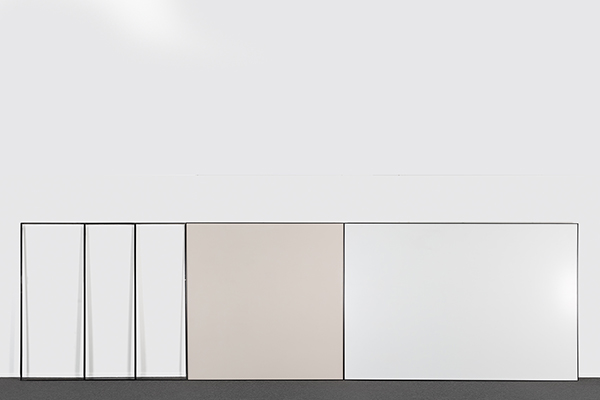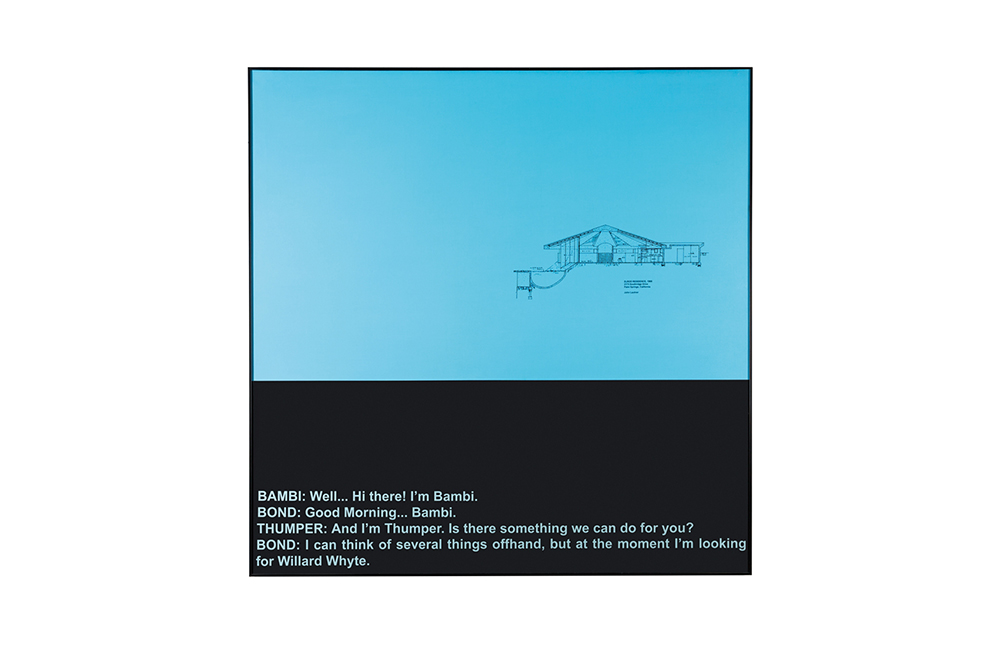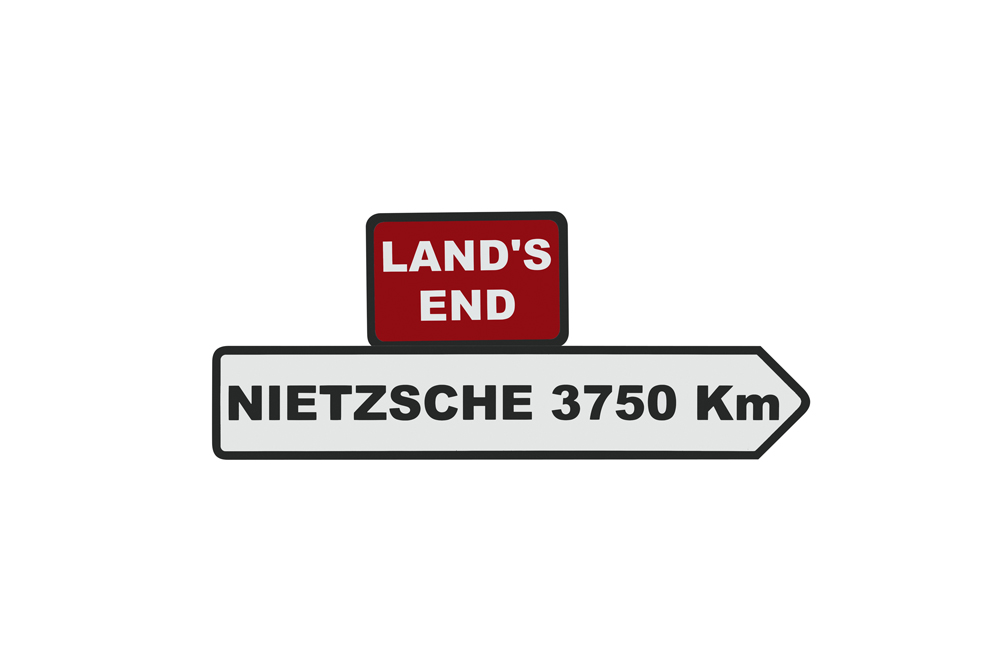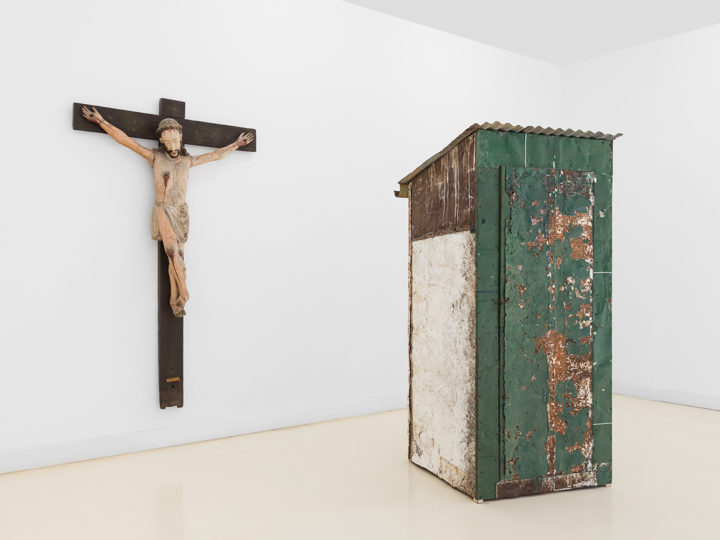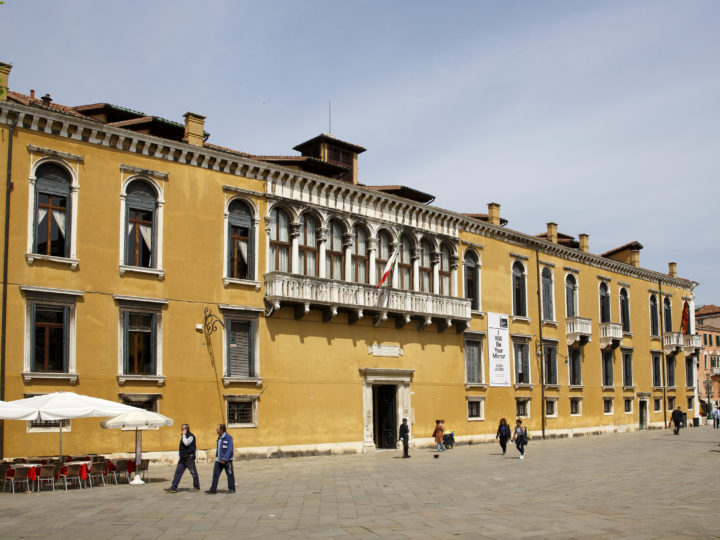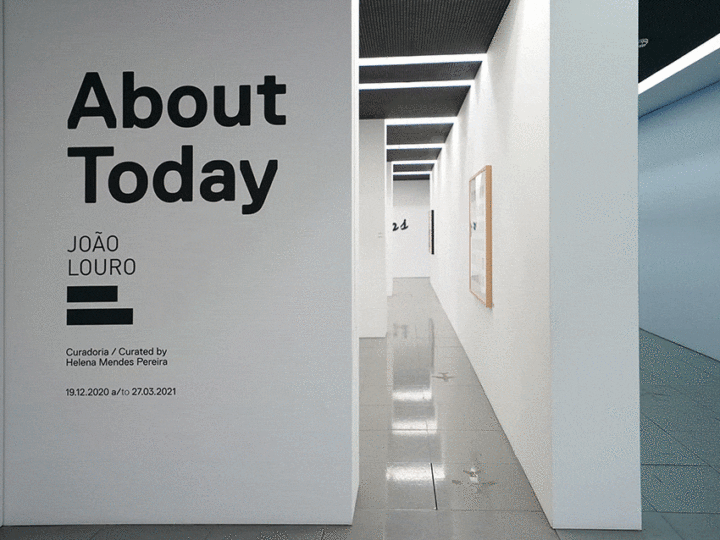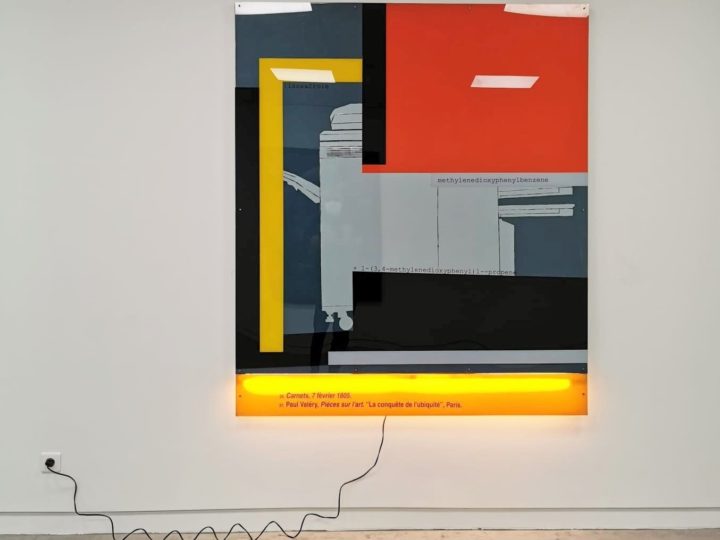João Louro’s work is eminently conceptual. His work is assumed as a strategic device for critical mediation of reality, exploring with some insistence the excess and the power of image and the written word in western societies. Considered a critic “of the symbolic economy that defines modernity”, João Louro often resorts to objects, signs, images and real situations, giving them new meanings, even if the references he employs keep the same appearance. The use of pre-existing elements, often combined unexpectedly in order to create new realities, constitutes a structuring device of his work. So, his body of work, including the “blind images”, inherently question the visual experience, a multiplicity of meanings and senses that go far beyond the physical work for which the spectator is attracted.
The exhibition conceived by João Louro for Bragança, comprised mostly of unpublished works, is based in the strong connection between the architectural space, the museum, viewed as a catalyst for a kind of work that appeals to the architecture of that same space as another form of architecture, which is the intimate space of a house: the Malaparte’s House. It is, therefore, regarding that house that Louro reinvents this experience that crisscrosses cinema, literature and art itself.
“Blind Images are artwork where image escaped from. (…) However those images never left their place, as in Houdini and in his tricks.”
João Louro in conversation with Jorge da Costa
Jorge da Costa/ As in Play, Rec and Pause, presented at Christopher Grimes Gallery in Santa Monica, U.S.A. there’s a notorious return to the “non-images”, only now deprived of the textual reference that earlier in your work permitted the viewer to, somehow, imagine or perceive the absent image or situation. Why?
João Louro/ I’m emphasizing the question of image. Earlier in my work I needed the connection between text and image (or its absence); now the text has escaped from the surface. These new Rothko’ s Blind Images separated the universe of writing from the one of the image. Now, to know what those monochromes are, we have to consult the Label. Only then can you make the “click”. The Blind Images are works in which the image escaped. Nobody knows how, or why…
JC/ As suggested in the reference to the famous magician and escaper that entitles the exhibition?
JL/ Exactly. It’s, somehow, the art of evasion. It’s minimal art! I don’t need major means: I just need that “frame” and an evocation. The spectator does everything else! However the image never left its place, as in Houdini and his tricks. The image was always there, in the mind of those who see the work.
JC/ But the absence of images necessarily gives the viewer the task of carrying on a reconstitution process, conferring them an active role.
JL/ I was always interested in the active viewer. And more than an active one, a participative one. That’s the only way to break through the actual paradigm, this means, from where we still communicate, the romantic paradigm of artist/spectator. That paradigm can be interrupted if the spectator concludes the artwork. That’s why I give so much importance to the viewer. Only he has the key to dismantle that paradigm.
JC/ But, doesn’t that mean that each artwork will eventually be perceived or mentally reconstituted regarding the viewer’s imagery limitations and seen in very different senses or even so in very unadjusted meanings?
JL/ In my opinion that’s an asset. That viewer’s imagery is what mostly interests me. My meanings are secondary and working with the viewer I flee from style, from the artist hand mark and from pretentiousness, which are the hallmark of many artists. I just concede a space, a fragment, a text, which will produce an effect I don’t control, nor do I want to control.
JC/ Mark Rothko, which you named from two of your works in this exhibition, tried through color, through monochromes to make the space visible, thereby evoking a particular place. However, the questioning that happens in your “Blind Images” is certainly different …
JL/ Well, Rothko is more the set up of an absence. Yes, I agree … My goal is the questioning of the visual experience, calling for images through the viewer. My purpose is different. I don’t present images. I only create the place where this could be possible. I don’t point the way. My action comes before it … I give a frame. Haven’t you ever seen film directors setting up a frame with their two hands? They simulate a rectangle with their forefinger and thumb and then they peek … That’s exactly what I do. I just give that frame so people can peek inside. I don’t describe any particular situation, I give some clues and then I let the viewer do the rest. Their images are those that appear through this frame. I just give them an exhibition space. It’s like the development of the photographic process … I create the sensitive space (the photographic paper) but the developer is the one who sees the work. It’s the viewer who sees the images. So I’m not interested in showing any particular place, nor a particular situation but to present a complex revelation mechanism (yet very simple.)
JC/ However works like “Site Scenes” lead us to very specific places, which have their spatial reference presented as an architecture plant, or appealing to very specific situations abducted from the cinematic world, which are a constant in your work.
JL/ Well … My work is vast. I often appeal to several approaches. In this specific case of “Site Scenes” more than the fragment, I also call on the architecture. These are works in which the frame is within the frame and create that other atmosphere approach that I wanted to creat in this exhibition, which is to place architecture within architecture.
JC/ This museum projected by architect Eduardo Souto Moura would then be assumed as a leitmotiv for creating a set of new artworks, capable of interfering or “talking” with the architecture of the exhibition space.
JL/ This space immediately interested me as soon as I started feeling it. I was willing to interact with it in an active way. This is a space that not only enables the display of artworks in an orderly or a common way, but it also participates in the artwork itself, transforming it. It is almost like if it was a skin. As a home … And by home I mean the architectural space but also the life within, with their own objects, people and situations. This is the kind of architecture that mostly interests me. A place that is alive and living.
JC/ So you bring into the interior of the museum a very specific architectural reference, which is the famous house of Curzio Malaparte in Capri.
JL/ Yes! As I told you before… There are works that are attractive to be seen in a place like this one and realize how they could interact … The “Malaparte House” is the gateway to the architecture of the museum. When you enter the space of the museum, it immediately becomes the interior of a house, through that precise work. As you can see, the name writing in that door, “Curzio Malaparte” is inverted. This means we are already inside the space and not at the front door. In that precise moment the space embraces us.
JC/ However, more than as in an architectonic space aren’t you rather suggesting people to enter as voyeurs in a private place which is the lonely refuge of the controversial Italian writer and simultaneously into his literary production (or even into his only film production “The Forbidden Christ”) as you did before with other movies such as “L. A. Confidential” or “Le Mépris?
JL/ It is an invitation for the viewer to lose himself among areas such as architecture, literature and cinema through my work.
JC/ In contrast with the monochrome of your “Blind Images” there are works like “Lucy in the Sky with Diamonds”, where you inscribed the chemical formula of the LSD, overloading the surface with information, making the approach from a wide variety of materials and techniques.
JL/ Well … that work is a kind of a laboratory wall. The viewer can lose himself in countless details and information. Sometimes the accumulative process interests me … I don’t point a way. I don’t give clues. It is an artwork coming from the field of archeology…
JC/ …resorting to the word. This appeal to thee written word as raw material is also very present in “L’Avenir Dure Longtemps”.
JL/ That work comes from the title of a book by Louis Althusser. In it, the philosopher defends himself for posterity of the crime he committed against his wife. It is written in the same line of a will once he was considered not imputable for the crime he committed and sent to a mental institution; he couldn’t stand before court to explain the motives which led him to perpetrate such barbarian act. This book deeply touched me and then I started to think ways to observe inside the words. This became increassingly appealing and interesting to me, until I understood that words have nuclear power. Perhaps some day when it becomes be possible to fission a word, we can find the same energy that exists inside an atom. As I followed this kind of thought, I developed these works that, far from reaching the core of the word, they nonetheless imply the dissection of sentences. It is from these dissected sentences that new meanings and new words come along. There is a whole new alphabet blossoming from the ancient words. There’s also the appearance of authors, we acknowledge the word “Durel”… can it refer to Lawrence Durrell? It is still an unsavory and puzzling map, but yet a powerful weapon.
JC/ However, resorting to words such as “Inferno” combined with the names of some major fashion capitals emphasizes the heavily critical approach your work holds.
JL/ I like the use of the popular symbol. I don’t look for something which has encrypted or esoteric connotations. That’s the main reason I recurrently use the western vocabulary and its symbolic language under the form of logos and trademarks. These symbols smooth the progress of my work. They are compressed information and I don’t need to describe any particular situation. The appearance of one of these symbols produces a complex situation. I have no particular interest as an artist in describing a landscape. I use a symbol that immediately leads to it. I just open a door, then the viewer can add their favorite trees, the animals he/she prefers and the river of his/her youth. That’s why, in my work, I only need to induce, never to describe.
JC/ This critical side of your work, owed to its continuous dialogue with the social contemporaneity, is brought to the limit when this approach includes the questioning of the American Way of Life.
JL/ America for me is a challenging universe. Without a sign…I mean, I have a love-hate relationship with America. It is this complexity that makes me visualize the face of human existence. It’s a huge laboratory of social experiences. America is a bench of nature sciences, with all the reagents at hand, without bureaucracy. Even when the drawers are closed, with some controversial issues, we can feel their smell. That’s what matters to me.
JC/ Beyond the critical intention, is there, in any way, any pedagogical intention, this means, a wish to call people’s attention to the problems of globalization?
JL/ I don’t see myself as a pedagogue. My purpose is to speak to the largest number of people. Nevertheless, I set up a fundamental and crucial rule – never to step down to the level of entertainment or to step up to the level of encryptation. This is my field of action, not always successfully, but this is the rule I bear in mind. Therefore, I attempt neither to be popular nor mediunic. I must also state that art is not politics. It doesn’t compete with politics, which demands a time-compressed action. Art stretches through time and, if it isn’t mere political propaganda, it will always replace politics. Art makes us understand the world and the art that most interests me allows me to understand the contemporary world.
JC/ Is it also having that in mind that you get hold of concrete objects, such as the highways panels, changing their initial role and subverting information?
JL/ I use concrete objects, such as highway signs because the viewer swiftly assimilates them. I don’t need to mediate. They are direct, perceptible and automatically incorporated. Everyone recognises them. Only then the second level of action begins, which are their contents. The viewer notices the “error” after having incorporated the form. This means that the form is the path that leads the viewer to the content, the second level of reading.
JC/ This call to pre-existing elements, which you so unexpectedly associate, still constitutes the structuring mechanism of your work, but the truth is that most of times we end up finding the meaning outside or beyond the formal materiality of the artwork…
JL/ The form is only a trap to attract viewer’s attention. Everything else is played after the work hostages his attention. And it’s in this field of action I want to play. It is when the artwork achieves its major relevance.
O trabalho de João Louro é destacadamente conceptual. Assume-se como um dispositivo estratégico de mediação crítica do real, explorando com alguma insistência o excesso e o poder da imagem e da palavra escrita nas sociedades ocidentais.
Considerado, por isso, um crítico “da economia simbólica que define a modernidade”, João Louro recorre muitas vezes a objetos; signos, imagens e situações da realidade, para lhe conferir novas significações, ainda que os modelos de referência de que se apropria mantenham a mesma aparência. A convocação de elementos pré-existentes, combinados muitas vezes de forma inesperada para a criação de novas realidades, continua a constituir-se como dispositivo estruturante do seu trabalho. Por isso, as suas obras, mesmo as “blind images”, têm intrínseca, como problematização da experiência visual, uma multiplicidade de leituras e de sentidos que estão muito para além da obra física para qual o espectador é atraído.
A base da exposição que João Louro conceber para Bragança, constituída maioritariamente por trabalhos inéditos, reside na forte ligação entre o espaço arquitectónico, concretamente o museológico, entendido como potenciador de uma linha de trabalho que convoca a arquitectura desse espaço como pele deuma outra arquitectura, que é o espaço intimista de uma casa: a casa Curzio Malaparte. É, pois, para essa casa que se reinventa uma vivência, que entrecruza o cinema, a literatura e a própria arte.
“As Blind Images são obras de onde a imagem se escapou. (…) Contudo a imagem nunca saiu do seu lugar, tal como em Houdini e os seus truques.”
João Louro à conversa com Jorge da Costa
Jorge da Costa/ À semelhança do trabalho “Play, Rec and Pause”, apresentado na Christopher Grimes Gallery, em Santa Monica, nos EUA, há um notório regresso às “não-imagens”, mas agora desprovidas do texto referencial que antes permitia ao espectador imaginar ou percepcionar, de algum modo, a imagem ou a situação em falta. Porquê?
João Louro/ Estou a agudizar a questão da imagem. Anteriormente necessitava da convivência entre texto e imagem (ou a falta dela); agora o texto escapou-se da superfície. Estas novas Rothko’s Blind Images separaram o universo da escrita do da imagem. Agora, para se saber o que são aqueles monocromos, tem que se consultar a tabela expositiva. Só nesse momento se faz o “clic”. As Blind Images são obras de onde a imagem se escapou. Ninguém sabe como, ou porquê…
JC/ Como sugere a referência ao famoso mágico e escapologista que intitula a exposição?
JL/ Exactamente. É, de algum modo, a arte da evasão. É uma arte mínima! Não necessito de grandes meios: apenas o tal “frame” e uma evocação. O espectador faz tudo o resto! Contudo a imagem nunca saiu do seu lugar, tal como em Houdini e os seus truques. A imagem esteve sempre no mesmo sítio, na cabeça de quem vê a obra.
JC/ Mas a imagem em falta obriga necessariamente o espectador a realizar um processo de reconstituição, conferindo-lhe um papel ativo.
JL/ Sempre me interessou o espectador ativo. E mais do que ativo, participante da obra. Só dessa forma se interrompe o paradigma vigente, isto é, o paradigma romântico de onde, ainda hoje, emitimos (artista e espectador). Esse paradigma pode ser interrompido se o espectador concluir a obra de arte. É por isso que dou tanta importância ao espectador. Só ele tem a chave para desmontar o paradigma vigente.
JC/ Isso não implica que cada obra acabe por ser percepcionada ou reconstituída mentalmente, conforme limitações ou o acervo imagético de cada espectador, conferindo-lhe sentidos muito díspares ou até desajustados?
JL/ Isso para mim é uma mais-valia. É esse acervo da cada espectador que me interessa. Aquilo que eu penso é secundário e nessa ação fujo ao estilo, à marca autoral, ao pretensiosismo, que são a marca de muitos artistas. Eu apenas concedo um espaço, um frame, um texto, que vai produzir um efeito que não domino, nem quero dominar.
JC/ Mark Rothko, nome com que intitulas duas das obras aqui presentes, tentou, através da cor, do monocromático, tornar o espaço visível, evocando assim um determinado lugar. No entanto, a problematização das tuas “Blind Images” é certamente outra…
JL/ Bem, o Rothko já é a invocação de uma ausência. Mas posso dizer-te que sim … A minha direção é a problematização experiência visual, convocando imagens através do espectador. O meu display é diferente. Eu não proponho imagens. Só crio o espaço para a sua formalização. Não remeto para nenhum local. A minha ação é antes disso… Eu dou um frame. Nunca viste os realizadores de cinema a a criarem o frame com as duas mãos? Fazem um rectângulo com o indicador e polegar e depois espreitam… É isso que eu faço. Dou um frame para espreitar para dentro. Como não descrevo nenhuma situação, dou algumas pistas e deixo que o espectador faça o resto. São as imagens do espectador que são convocadas através desse frame. Eu apenas lhes concedo um espaço de exposição. É como a revelação fotográfica… Eu crio o espaço sensível (o papel fotográfico), mas o revelador é de quem vê a obra. É o espectador que vê as imagens. Portanto não é um lugar o que me interessa mostrar, nem nenhuma situação, apresento um mecanismo complexo de revelação, aparentemente muito simples.
JC/ No entanto, obras como as “Site Scenes” conduzem-nos a lugares muito concretos, cuja referência espacial é apresentada sob a forma de uma planta, ou convoca cenas muito precisas, subtraídas ao universo cinematográfico, um referente muito presente no teu trabalho.
JL/ Bem… o meu trabalho é vasto. Utilizo várias aproximações. No caso das “Site Scenes”, para além do frame, incluo ainda a arquitectura. São obras em que o frame está dentro do frame e que ria a outra parte da atmosfera que gostaria de trazer para esta exposição, que é meter a arquitectura dentro da arquitectura.
JC/ Este projecto arquitectónico de Souto Moura viria então a assumir-se como leitmotiv para a criação de novas obras, capazes de interferir ou dialogar com a arquitectura do espaço expositivo.
JL/ O espaço interessou-me logo que o vivi. Fiquei com vontade de interagir com ele de uma forma mais activa. Não é um espaço que suporta obras de arte de forma regrada e disponível, mas antes participa na obra, transforma a obra. É como se fosse uma pele que contém obras de arte. Quase como uma casa… uma casa é a arquitectura e a vida que aí se produz, com os seus objetos, pessoas e situações. É essa arquitectura que me interessa. É um lugar de vida.
JC/ Ou seja, convocas para o interior do espaço museológico um espaço arquitectónico muito concreto como é o caso da famosa casa de Curzio Malaparte, em Capri.
JL/ Sim! Como te disse anteriormente há obras que é apetecível ver num espaço como este e apercebermo-nos como interagem… “A Casa Malaparte” é a porta de entrada para a arquitectura do museu. Entra-se no espaço do museu, que passa a ser o espaço interior de uma casa através daquela obra. Como se vê, o nome que está inscrito naquela porta “Curzio Malaparte” está ao contrário. Nós já estamos dentro do espaço, não ficamos à porta. Aí, nesse preciso momento, o espaço acolheu-nos.
JC/ Desse modo, mais do que para um espaço arquitectónico não estás antes a sugerir ao visitante que entre, como voyer, num espaço privado, no refúgio solitário do polémico e contestatário escritor italiano e, simultaneamente, para a sua produção literária ou até mesmo para a sua única obra cinematográfica “O Cristo Proibido”, como fizeste antes com outros filmes, como “L.A. Confidential” ou “Le Mépris”?
JL/ É um convite ao visitante a perder-se entre a arquitectura, a literatura, o cinema, através da minha obra.
JC/ Por oposição ao monocromático das tuas “Blind Images” estão obras como “Lucy in the Sky with Diamonds”, onde inscreves a fórmula química do LSD, sobrecarregando a superfície de informação, fazendo a abordagem a partir de uma grande diversidade de materiais e técnicas.
JL/ Bem… essa obra é uma espécie de parede de laboratório. É pela exaustão. O espectador pode perder-se em inúmeros detalhes e informações. Por vezes o processo acumulativo interessa-me… não indico nenhum caminho. Não dou pistas. É uma obra mais do campo da arqueologia.
JC/ … que recorre à palavra. E este recurso à palavra escrita como matéria de trabalho está também muito presente na obra “L’Avenir Dure Longtemps”.
JL/ Esta obra foi produzida a partir do título de um livro de Louis Althusser. Nesse livro, o filósofo defende-se, para a posteridade, do assassinato da sua mulher. É um livro escrito em tom de testamento já que, ao ter sido considerado inimputável do crime que cometeu e ter sido colocado numa instituição mental, não pode defender-se em tribunal dos crimes que o levaram a cometer tão bárbara ação. Foi um livro que me tocou profundamente e comecei, a partir dele, a elaborar formas de espreitar para dentro das palavras. Isto começou a interessar-me e atrair-me cada vez mais, ao ponto de chegar à conclusão de que as palavras têm poder nuclear. Talvez um dia, quando se conseguir fender uma palavra, encontremos o mesmo tipo de energia que encontramos dentro de um átomo. Ao seguir este pensamento, desenvolvi obras que, ainda longe de aceder ao ao conteúdo da palavra, são já a desmontagem das frases. É dessas frases desmontadas que surgem os novos sentidos e novas palavras. Há um alfabeto novo a aparecer no meio de palavras antigas. Surgem também autores (pode ver-se que surgiu a palavra “Durel”… será Lawrence Durrell?). É um mapa ainda insípido e desconcertante, mas estou certo, uma ferramenta poderosa.
JC/ No entanto o recurso a palavras como “Inferno”, associada aos nomes das grandes capitais da moda, não deixa de sublinhar a faceta profundamente crítica de que se reveste o seu trabalho.
JL/ Eu gosto do uso do símbolo popular. Não procuro nada que tenha conotações encriptadas, esotéricas… Nesse sentido encontra-se no meu trabalho o uso recorrente do vocabulário da sociedade ocidental, a sua linguagem simbólica em forma de logótipos e imagens de marca. Esses símbolos facilitam-me o trabalho. São compactos de informação e não preciso descrever uma situação. A situação apresenta-se complexa com o aparecimento de um destes símbolos. Como artista não me interessa descrever uma paisagem. Utilizo algo que remeta imediatamente para isso. Abro uma porta, depois o espectador que lhe coloque o tipo de árvores que quiser, os animais que mais gosta e o rio da sua juventude. É por isso que no meu trabalho só preciso induzir e nunca descrever.
JC/ Esse lado crítico, pelo continuo diálogo com a contemporaneidade social é levado ao extremo quando a abordagem se estende à problematização do “American Way of Life”.
JL/ A América é um universo de interesse para mim. Sem sinal… Isto é, tenho uma relação de ódio e de amor com a América. E é essa complexidade que me faz sentir os contornos da existência humana. É um grande laboratório de experiências sociais (e não só). A América é uma bancada de ciências naturais, com todos os reagentes à mão, sem burocracias. Mesmo quando as gavetas estão fechadas, com alguns assuntos polémicos, conseguimos sentir o seu cheiro. É isso que me interessa.
JC/ Há, de algum modo, para além da intenção crítica uma intenção didática, isto é, chamar a atenção para problemas que, à escala da globalização, são também já muito nossos.
JL/ Eu não me considero um pedagogo. A minha intenção é falar ao maior número de possível de pessoas, contudo, estabeleço uma regra fundamental e elementar: não descer ao nível do entretenimento nem, tão pouco, me elevar ao nível do encriptado. É nessa faixa de ação que me movo. Nem sempre com sucesso, mas tenho sempre esta regra em mente. Por isso não procuro nem ser popular, nem mediúnico. Dito isto, devo dizer que a arte não é política. Não concorre com a política que exige um tempo comprimido de ação. A arte estende-se no tempo e, se não for propaganda política, substitui-se sempre à política. A arte faz-nos entender o mundo. E a arte que mais me interessa faz-me entender o mundo contemporâneo.
JC/ É também por isso que te aproprias de objetos concretos como a multiplicidade de painéis informativos das auto-estradas, alterando-lhes a função inicial, subvertendo a informação?
JL/ Os objetos concretos, como os painéis de auto-estrada, utilizo-os porque são rapidamente absorvidos pelo espectador. Eu não necessito de estar a mediar. São diretos, perceptíveis e automaticamente assimiláveis. Todas as pessoas os reconhecem. Só depois se processa o segundo nível de ações, que são os seus conteúdos. O espectador deteta o “erro” depois de ter assimilado a forma. Isto quer dizer que a forma é a porta que vai levar o espectador até um segundo nível de leitura.
JC/ Esta convocação de elementos pré-existentes, que associas de forma inesperada, continuam a constituir-se como o dispositivo estruturante do teu trabalho, mas a verdade é que o sentido acaba por se encontrar quase sempre fora ou para além da materialidade formal da obra…
JL/ Esta forma é apenas uma armadilha para atrair a atenção do espectador. Tudo se joga após esse “sequestro” da atenção. E é nesse campo de ação que interessa atuar. É aí que a obra ganha a sua relevância.
